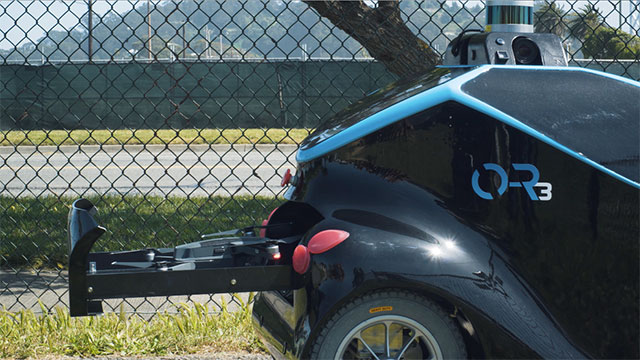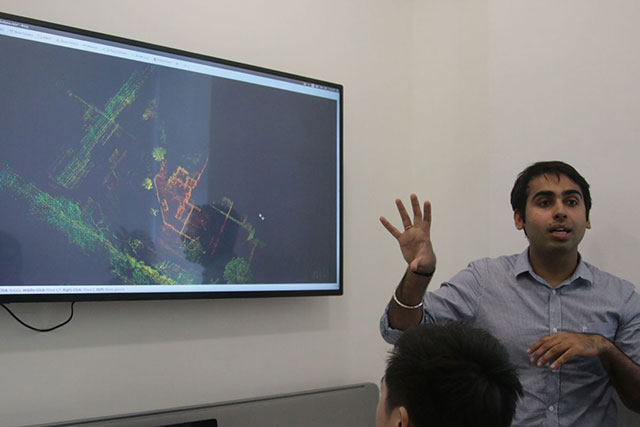Robotic guards integrate drones to chase the thief
O-R3 is an autonomous robot of Otsaw Digital, recently equipped with more drones to be able to chase the intruder when needed. Otsaw's integrated drone in this robot helped expand the robot's ground protection ring to 100m, allowing O-R3 to do things that many other bodyguard robots could not do.
" If we encounter an obstacle on the ground, we can launch the drone to get an aerial view, thus knowing where the thief is hiding, like a wall, fence or gate . ", Ling Ting Ming, CEO of Otsaw Digital and parent company ActiV Technology.
Besides the built-in drone, O-R3 can also identify intruders or suspicious objects such as derelict bags. It has the ability to alert the control center. O-R3 can also charge itself when the battery runs out.

Images from robots are sent to the control center
To do that, the O-R3 is equipped with data. Otsaw said they use machine learning to make the robot differentiate between a normal visitor, an employee and a thief.
" The more data you get, the more you will learn ," Ling said. " At first, we just showed it to the simple objects. If a masterless bag was left unnoticed for 5 minutes, it would ring the bell. We also let it distinguish the staff and intruders. Whatever sometimes it is wrong in the learning process but it is getting better and better ".

The O-R3 and the integrated drone
The upcoming company will launch an outdoor version of the O-R3 at CommunicAsia2017. The outdoor version with 5km protection ring and the size of a golf cart with the indoor version, a small robot with no LIDAR 3D sensor (laser scanning technology from the air) and drone, are in finishing process.

Gautam Noong, Otsaw's chief technology officer introduced the ability to create 3D maps with LIDAR sensor of O-R3
Bodyguard robots are not new inventions, they have been used in places like corporate campuses in Silicon Valley or Chinese railway stations. Currently, they are becoming increasingly popular, especially in countries where the cost of hiring guards is increasing. Countries like Singapore spent $ 5,763 a month for two bodyguards working on 12-hour shifts.
Otsaw wanted to hire these robots as a service for about $ 10,000 per month. Another security service company, Ademco, is proposing a price of $ 5,403 per month.
That doesn't mean robots can replace people. Ling said that people will have to move to higher skills. " I believe that humans are irreplaceable. Robots can only help. " Otsaw is also planning to create automatic road sweeping robots with cheaper LIDAR technology. " In the near future, maybe the next 6 months, simple tasks can let robots do it ," Ling said.
You should read it
- Astro - the most realistic robot dog today, can interact with humans
- Robot milliDelta robot is set up with roles in production and medicine
- Primer - Super transform robot like Transformer
- Giant Robot War: America wins Japan
- The world's first terrain-crossing robot can move like a snake
- 10 robots have succeeded in proving they are new generation animals
- This 'octopus' robot arm can stick to almost any object
- Russian new robots can shoot themselves with two hands like humans
May be interested
- Use mosquito repellent materials available, safe for families
 no need to use chemical insect repellents or insect repellent creams, you can protect your family from mosquitoes with extremely simple ingredients like ...
no need to use chemical insect repellents or insect repellent creams, you can protect your family from mosquitoes with extremely simple ingredients like ... - The smart way to integrate iCloud with Windows 10
 do you have an iphone or ipad but use a windows pc? it is not strange. if this is the case, you'll wonder how you can access icloud from windows 10.
do you have an iphone or ipad but use a windows pc? it is not strange. if this is the case, you'll wonder how you can access icloud from windows 10. - The world's first airport for unmanned aerial vehicles is about to start
 this ambitious project is the brainchild of years of research and investment by chinese flying car maker ehang.
this ambitious project is the brainchild of years of research and investment by chinese flying car maker ehang. - How to Integrate ChatGPT with VSCode for Increased Productivity
 you can bring ai support directly into visual studio code (vscode) by adding chatgpt to it.
you can bring ai support directly into visual studio code (vscode) by adding chatgpt to it. - Contemplating the performance of the drone model has a tremendous 'evasion index'
 drones or drones are a small, interesting and agile technology toy that can help people complete complex tasks. but the level of flexibility of unmanned aircraft today is still one thing that makes developers 'headaches'.
drones or drones are a small, interesting and agile technology toy that can help people complete complex tasks. but the level of flexibility of unmanned aircraft today is still one thing that makes developers 'headaches'. - How to integrate Google authentication in Next.js app using NextAuth
 nextauth.js is an open source authentication library that simplifies the process of adding authentication and authorization functionality to next.js applications and customizing the authentication process.
nextauth.js is an open source authentication library that simplifies the process of adding authentication and authorization functionality to next.js applications and customizing the authentication process. - Watch the ingenious robot hand catch a jellyfish without injuring it
 there is a revolution in the field of manufacturing robots with comprehensive changes in materials.
there is a revolution in the field of manufacturing robots with comprehensive changes in materials. - What is Iconify? How to integrate Iconify into Vue . app
 you want to enhance your vue application with . then let's learn how to integrate iconify into vue app !
you want to enhance your vue application with . then let's learn how to integrate iconify into vue app ! - Steps to integrate Google Calendar into Outlook 2013
 if you are using outlook 2013 to send and receive mail with the use of the google calendar online calendar service, you can apply the following tips to integrate these two great services to help better. your job.
if you are using outlook 2013 to send and receive mail with the use of the google calendar online calendar service, you can apply the following tips to integrate these two great services to help better. your job. - This 'octopus' robot arm can stick to almost any object
 the robot arm is soft, skillful and extremely intelligent, able to identify and hold nearly every object in its power, with the shape inspired by the octopus tentacles.
the robot arm is soft, skillful and extremely intelligent, able to identify and hold nearly every object in its power, with the shape inspired by the octopus tentacles.









 Reveal the augmented reality glasses of Microsoft Research
Reveal the augmented reality glasses of Microsoft Research Windows applications use the least amount of computer resources
Windows applications use the least amount of computer resources Russian Hacker is using Google's own infrastructure to hack Gmail users
Russian Hacker is using Google's own infrastructure to hack Gmail users 20 tips for new Chromebook users should know
20 tips for new Chromebook users should know 10 key points at Google I / O 2017
10 key points at Google I / O 2017 See when Google brings Android and virtual assistants to what cars will look like
See when Google brings Android and virtual assistants to what cars will look like